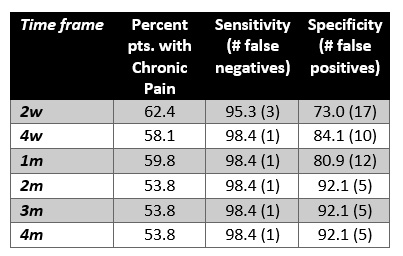Background:
In Sickle Cell Disease (SCD), chronic pain, i.e., pain on most days over a 6 month time period, is a major complication associated with substantial morbidity and poor outcomes. In the landmark Pain in Sickle Cell Epidemiology Study (PiSCES), the largest study of pain in SCD, one-third of individuals age 16 years or older had daily or near-daily pain, and >50% had chronic pain. However, PiSCES required patients to have 5-6 months of completed diaries in order to qualify for chronic pain analysis. Practically, the International Association for the Study of Pain (IASP) has used three months as the interval upon which to base a definition of chronic pain. Shorter daily assessment intervals upon which to reliably base a definition of chronic pain would reduce respondent burden, and would improve the frequency and accuracy of pain phenotyping for clinical and research purposes.
Method:
We chose as the gold-standard for chronic pain definition subjects enrolled in PiSCES that had at least 5 months of daily diaries (n=127). We excluded 10 patients who had at least 182 diaries (essentially 6 months), but had at least 50% of diaries missing in any of months 1-4. We simulated daily diary assessment over less burdensome, shorter intervals, always beginning on day one of assessment, to mimic what would be done clinically. We chose the time frames of 2 weeks (2w), 4 weeks (4w), 1 month (1m), 2 months (2m), 3 months (3m), and 4 months (4m).
To operationalize the definition of chronic pain, we used a definition of pain severity rated as >0 on > 50% of diary days, regardless of interval. To determine if using diaries collected over a shorter period of time would still classify patients correctly, we calculated the sensitivity and the number of false negatives, as well as the specificity and number of false positives of each simulated diary interval.
Results:
Within the gold standard sample, 51.3% of patients had chronic pain based on all diaries submitted. The Table shows the percent of patients diagnosed with chronic pain, the sensitivity as well as the number of false negatives, and the specificity as well as the number of false positives, for each simulated diary interval. Simulated intervals of two months or more of daily diaries yielded chronic pain percentage estimates with both high sensitivity and high specificity, compared to the gold standard estimate. Simulated intervals of two week and four weeks yielded increasingly lower specificity, i.e., increasingly more false-positive indications of chronic pain, as the interval shortened. However, each interval still yielded high sensitivity-few patients with gold-standard chronic pain were missed, even at two weeks. Results were very similar even if data from the entire 127 participants was used.
Conclusion :
For determining the presence of chronic SCD pain, defined as pain on more than 50% of days enrolled in PiSCES, simulated intervals of two months or more of daily diary collection yield both very good sensitivity and very good specificity, compared to intervals of 5-6 months. Clinicians and researchers may reliably choose to adopt two months of dairy collection, as a matter of practicality, to reduce respondent burden when phenotyping SCD pain as acute versus chronic.
Disclosures
Smith:Agios: Consultancy, Research Funding.


This feature is available to Subscribers Only
Sign In or Create an Account Close Modal